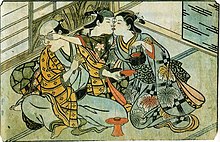Bisexuality
As bisexuality (actually Ambisexualität , after the Latin prefix bi- for two ) refers to the sexual orientation or inclination to more than one sex to feel emotionally / or sexually attracted and. The adjective bi is used as a short form . Bisexuality, along with other orientations such as pansexuality, is one of the non- monosexual orientations.
Change of concept
Until the beginning of the 20th century, bisexuality was considered to be the presence of two kinds of gender characteristics in an individual, which today would be classified as hermaphroditism , hermaphroditism or intersexuality . The thesis of constitutional bisexuality also assumes that this is the normal development process of human sexuality and gender development. Every facility is there; as a rule, however, one binary gender characteristic would develop further, while the other would remain rudimentary . For humans, the sex chromosomes ( gonosomes ) are regarded by genetics as the determining factor for this development .
In the course of the 20th century, this concept of developmental biology was displaced by a conception that describes a sexual or erotic orientation in both science and colloquial language. As a result of the patriarchal foundation and structure of many premodern societies, reliable historical statements are often limited to the sexuality of men. A literary movement that reflected female interests did not emerge until later. The love between two friends was one of the most popular topics. However, manifest sexual relationships were generally left out because of their social offensive nature. Instead, in eighteenth-century Europe, for example, there was talk of the friendship or kinship between two women, which could not be interrupted even by marriage to a man. It was somewhat different in the Arab world when the world of women came into the focus of literature.
In 1915 Sigmund Freud put forward the thesis that the original disposition of humans was bisexual.
"To psychoanalysis [...] the independence of the object choice from the sex of the object, the equal free disposal over male and female objects, as can be observed in childhood, in primitive conditions and in early historical times, appears to be the original, from which restriction results the normal [ie heterosexual] as well as the inversion type [ie homosexual] develop in one direction or the other. In the sense of psychoanalysis, the exclusive sexual interest of men for women is a problem that needs to be clarified and is not a matter of course [...] "
Freud never made clear statements about the causes of this “restriction”. In other writings, especially in connection with the Oedipus complex , he seems to assume heterosexuality as an original disposition of at least the man, while homosexuality, on the other hand , appears to be a deviation caused by certain family constellations. Until the 1970s, many psychoanalysts did not discuss the bisexuality thesis and viewed homosexuality as a mental illness .
Scientific research in western industrialized countries
It is difficult to estimate how high the proportion of bisexuality in the population is. Statements in the literature vary widely. The Kinsey Report is often cited, which in 1948 classified around 46% of the male population as "to a certain extent bisexual". In fact, bisexual orientations are rarely lived out. Some sexologists explain this with the enforcement of a monosexual norm or heteronormativity in our culture.
A British study by the polling institute YouGov from 2015 found a share of 19% bisexual (people who rate themselves on the Kinsey scale in the range of 1 to 5), among 18 to 24 year olds even 43% are bisexual. Only 2% of the respondents use the term "bisexual" for themselves. A study by the University of Essex led by Gerulf Rieger came to the conclusion that 74% of women who describe themselves as heterosexual and 82% of all women are bisexual. The research examined physical responses (such as dilated pupils) to viewing naked people in videos. The TAZ editor Saskia Hödl pointed out in a comment that in another study similar physical reactions could also have been detected when watching videos of copulating monkeys.
A Swedish study of identical twins from 2008 sees a complex relationship between various factors that control sexual orientation . The study comes to the conclusion that the expression of this orientation in men has a genetic influence of about 35% (women about 18%); however, it is unclear what other factors also play a role. What seems certain, however, is that early childhood experiences or upbringing play no role at least in the development of male sexual orientation.
Researchers from Denmark and the United States published an article in Archives of Sexual Behavior magazine in 2017 in which they concluded that women and men who were exposed to the hormone progesterone before birth are more likely to be bisexual.
A controversial study of bisexual men in the USA published in 2005 came to the conclusion that bisexual self-designation only means sexual preference for two genders in about two percent of cases. Three quarters of the subjects designated as bisexual are homosexual, the rest are heterosexual. The basis of this statement was the sexual arousal of the penis, measured by an apparatus, while viewing erotic image material that showed either men or women. The investigation received public attention following a report in the New York Times . The study is rejected by the National Gay and Lesbian Task Force , which pointed out methodological weaknesses. In addition, the organization Fairness and Accuracy in Reporting (FAIR) criticized the New York Times had failed to draw attention to previous publications by co-author J. Michael Bailey. In the past, he had advocated the right of parents to exclude homosexual offspring with the help of eugenics as soon as this was technically possible.
Bisexuality in other cultures

In some societies, such as Greco-Roman antiquity or the Islamic world, the erotic attraction to two sexes was considered the almost universal norm. The exclusive fixation on one gender, now referred to as homosexuality and heterosexuality, was rarely made an issue. Wherever this happened, for example in pseudo-Lukian's The Species to Love , the ironic intention of the author is unmistakable. One of the two discussants in this fictional dialogue from the beginning of the fourth century AD is treated with the stigma of effeminacy because his erotic interest is directed exclusively to women, while the other appears as an owl because he is due to his sexual inclinations runs an all-male household.
Many Islamic clergymen of the Middle Ages also saw, although they rated same-sex intercourse as a grave sin according to their religion , the erotic attraction towards two sexes was a basic fact of human existence. The Hanbali legal scholar Ibn al-Jschauzī, who died in 1201 AD, wrote : “He who claims that he has no desire [when he sees beautiful boys] is a liar, and if we could believe him, he would be an animal, not a human being. "
Sexual relationships were relatively openly referred to by their name in Islam. The term sihaq (dt. "Rubbing") was used as a term for the sexual practice of tribady . In literary terms, the love between two women was not constructed as a contradiction to marriage, although some lawyers viewed tribadia as a criminal extra-marital activity. Their proof by the four eyewitnesses required by Sharia law was practically impossible, so that this prohibition remained purely theoretical.
Bisexuality in the Animal Kingdom
Bisexuality is relatively common in the animal kingdom. The bonobos , for example, are a completely bisexual species that is best known for its pronounced lesbianism . A multifunctionality of sexual behavior that goes beyond the multiplication is assumed here.
See also
literature
- Agnes Frei: Love men and women: Bisexuality - the second seventh heaven. Essays and reports, poems and stories. Reinbek near Hamburg 1989, ISBN 3-499-12542-0 .
- Marjorie Garber: The variety of desire. Bisexuality from ancient times to today. Frankfurt am Main 2000, ISBN 3-596-14817-0 .
- Bettina Schmitz: Psychical bisexuality and gender difference , Passagen Verlag, Vienna 1996, ISBN 3-85165-242-8 .
Web links
- Nationwide active association BiNe Bisexual Network e. V
- The bisexual revolution , 56-minute documentary by ARTE from 2008
- Sexual cross-border commuters at stern.de
- Taboo topic bisexuality: On the stigma of being into women and men , 2018 radio report that was awarded the Felix Rexhausen Prize , broadcast on Deutschlandradio Kultur
- Bisexuality, radio broadcast March 2003, Ulrike Kadi presents a lecture by Bettina Schmitz ( PDF ; 151 kB)
Individual evidence
- ↑ The Bi-Term. BiNe - Bisexual Network e. V., accessed on June 9, 2020 .
- ↑ Understanding Bisexuality. American Psychological Association, accessed June 9, 2020 .
- ^ Definition - Bisexual.net. Retrieved March 28, 2020 .
- ↑ H.-J. Voss: Gender: Against naturalness. Butterfly, Stuttgart 2011.
- ↑ Lizzie Buchen: The fickle Y chromosome. In: Nature , Volume 463, 2010, p. 149, doi: 10.1038 / 463149a , full text
- ↑ Sigmund Freud: Three treatises on the theory of sex. The study first appeared in 1905; the quotation given above is an addition to the 1915 edition. Here quoted from: Sigmund Freud, study edition , Volume V Sexualleben . Edited by Alexander Mitscherlich, Angela Richards, James Strachey. Frankfurt am Main (S. Fischer Verlag), 4th edition 1972, p. 56.
- ^ Alfred C Kinsey: Sexual Behavior In The Human Male . 1949, p. 656 ( archive.org [accessed December 31, 2019]).
- ↑ Is there heterosexuality? , by Gunter Schmidt
- ↑ Renate-Berenike Schmidt, Uwe Sielert: Handbook on Sexual Education and Sexual Education , ISBN 978-3-7799-0791-6 , ( online )
- ^ 1 in 2 young people say they are not 100% heterosexual , YouGov UK, August 14, 2015.
- ↑ Deutsche Welle (www.dw.com): Bisexuality - "You don't belong to us!" | DW | 23.10.2018. Retrieved on March 28, 2020 (German).
- ↑ Jen Yockney: This is why more young people say they are not 100% straight or gay , gaystarnews.com, August 18, 2015
- ↑ Most women are bisexual or gay but never straight, study suggests. New York Times , November 5, 2015, accessed November 17, 2015 .
- ↑ Getting in touch with our female sexuality. (No longer available online.) University of Essex , November 5, 2015, archived from the original on November 18, 2015 ; accessed on November 17, 2015 .
- ↑ a b Stimulus-reaction machine_ woman . November 5, 2015, accessed November 17, 2015 .
- ↑ So close to the other bank , Die Zeit
- ↑ Augsburger Allgemeine: Study: Does Progesterone Change Sexual Orientation? Retrieved March 28, 2020 .
- ^ G. Rieger, ML Chivers, JM Bailey: Sexual arousal patterns of bisexual men. Psychol Sci. 2005 Aug; 16 (8): pp. 579-584. PMID 16102058
- ^ Benedict Carey: Straight, Gay or Lying? Bisexuality Revisited. New York Times, July 5, 2005
- ^ National Gay and Lesbian Task Force: The Problems with "Gay, Straight, or Lying?" ( Memento July 22, 2011 in the Internet Archive ), July 2005
- ↑ Fairness & Accuracy in Reporting: New York Times Suggests Bisexuals Are “Lying”. Paper fails to disclose study author's controversial history. , July 8, 2005.
- ↑ See AS Greenberg, J. M. Bailey: Parental selection of children's sexual orientation. Arch Sex Behav. 2001 Aug; 30 (4): pp. 423-437. PMID 11446202
- ↑ Islam and "gay" love poetry in Moorish Spain ( memento of September 29, 2007 in the Internet Archive ). Text excerpt from: John Boswell, Christianity, Social Tolerance, and Homosexuality (transl.)
- ↑ ... like grating saffron , taz of March 14, 1996
- ^ Marriage, Adultery and Homosexuality (Entl.), On people.well.com

